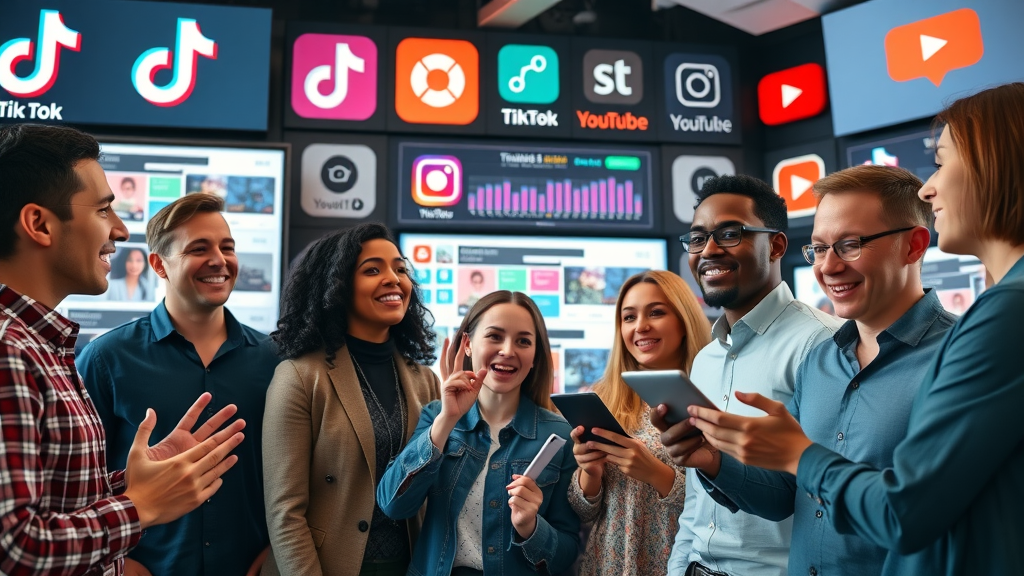
Did you know that digital ad spending worldwide is projected to soar past $700 billion in 2024? As digital marketing trends rapidly evolve, brands and digital marketers must stay ahead or risk falling behind. This year marks a seismic transformation in how companies use digital advertising to reach growing, tech-savvy audiences fueled by innovations like generative AI, video content, and powerful social platforms. In this opinion-led guide, you’ll learn which marketing trends truly matter, why they deserve your full attention, and how to leverage them for a lasting competitive advantage. Let’s dive deep into the future of digital ad success!
Why Digital Advertising Trends for 2024 Demand Your Attention
"Digital ad spending worldwide will surpass $700 billion in 2024, reflecting a seismic shift in marketing strategies and digital marketing trends."
The digital advertising landscape is undergoing unprecedented change. As brands shift budgets from traditional media ad investments to digital media, the power dynamics of customer engagement and campaign success are rapidly redefined. In 2024, digital marketers face a crucial choice: adapt to these marketing trends or risk missing out on measurable ROI and audience growth. The explosive rise of artificial intelligence , evolving social platform features, and the dominance of video content signal a new era in targeted advertising. These digital marketing trends make it clear—your next move determines whether you lead the pack or trail behind.
Consider practical examples: companies harnessing generative AI produce unique, audience-tailored generated content that elevates their digital ad campaigns. Meanwhile, voice search and multi-channel approaches allow marketing strategies to be personalized and accessible anywhere. Social commerce and video ad formats on platforms like TikTok and Instagram redefine what high-performing digital advertising means for brands worldwide. By proactively investing in these top digital marketing strategies now, organizations can maximize ad spend, drive engagement, and solidify their market presence for years to come.
Critical Digital Marketing Trends Shaping the Future of Advertising
"The only constant in digital advertising is change—successful brands are those adapting to new digital marketing trends before the rest."
Evolving Role of Generative AI in Digital Advertising Trends

Generative AI is quickly transforming the face of digital advertising trends in 2024. Leading AI tools help marketers generate custom graphics, video ad scripts, and compelling written content in seconds—slashing campaign production times and giving teams more flexibility to experiment. The latest AI-powered platforms use machine learning to analyze past campaign data and predict which generated content will resonate most with each audience segment.
The impact isn’t just creative—it’s measurable. Brands deploying generative AI strategically see their digital ad engagement and conversion rates improve drastically. With AI tools now capable of personalizing every touchpoint, digital marketing trend adopters are discovering new ways to deepen the customer experience while staying agile in shifting digital ad markets.
Digital Marketing Strategies Adapting to Artificial Intelligence and Machine Learning
Artificial intelligence and machine learning are more than buzzwords—they are the backbone of effective digital marketing strategies for the coming year. AI-powered campaign automation lets digital marketers optimize ad spend, tailor messaging to specific demographics, and even manage bidding in real-time for better CPM and ROI. As these machine learning systems evolve, so do the ways marketers can use customer insights to deliver hyper-relevant ads across social media platforms, display networks, and beyond.
Brands that quickly adapt to these digital marketing trends will find themselves ahead, combining sophisticated data analysis with creative execution. With artificial intelligence at the helm, even small marketing teams can run complex, multi-platform campaigns that rival those of major global brands. This leap in scalability and personalization is shaping marketing trends and giving forward-thinking companies a lasting competitive advantage.
How Generative AI Creates Superior Generated Content
Generative AI technology empowers businesses to create unique, on-brand visuals and copy at scale, redefining what’s possible for digital advertising trends in 2024. The most advanced ai tools synthesize past performance data, customer behavior, and trending keywords to craft highly tailored generated content—delivering digital ads with higher engagement rates. From banner graphics to video scripts, generative AI ensures messaging is timely and relevant, no matter the target audience or platform.
Machine Learning Powering Personalized Digital Advertising
Machine learning now powers powerful personalization engines that help brands deliver the right message to the right person at just the right time. These advanced systems track real-time user data on everything from browsing behaviors to purchase patterns, seamlessly optimizing campaigns and driving measurable results. By leveraging machine learning, digital marketers can dynamically adjust targeting, content, and budgeting—making every dollar of ad spend go further as competition in the digital ad space heats up.
Voice Search Optimization: A New Frontier for Digital Ad Campaigns
"By 2024, 50% of all searches will be voice-based—changing how digital advertising targets consumers."

As smart speakers and mobile devices become ubiquitous, voice search optimization emerges as the latest frontier for digital ad campaigns. The rise of voice assistants like Alexa, Google Assistant, and Siri is rewriting the rules for keyword targeting and digital marketing strategies. Brands that fail to update their campaigns for natural language queries risk missing out on the half of all search traffic predicted to be driven by voice in 2024.
To master this shift, digital marketers must focus on conversational keyword optimization and structured data markup to make their content easily discoverable through voice search. Ad creative, call-to-actions, and even product listings are evolving to be more compatible with voice-activated devices, ensuring that brands are accessible where, when, and how customers are asking. As voice search solidifies its role in marketing trends, only the most adaptive brands will reach these engaged, on-the-go consumers.
Emerging Marketing Trends on Social Platforms You Can’t Ignore in 2024
Social Media Giants and the Transformation of Digital Ad Spend
Social media giants are the architects of today’s most influential digital advertising trends, especially as they continue to claim an ever-larger share of global ad spend. Platforms such as TikTok, Instagram, and YouTube aren’t just vehicles for ads—they are fully immersive media platforms where brands interact directly with engaged communities. In 2024, spending on digital advertising within these social platform environments is projected to outpace all other channels, as brands recognize the peer-driven power of social media.
This shift signals a radical transformation in the way digital ad budgets are allocated. While traditional media ad investments decline, digital advertising spend surges, prioritizing–interactive video ad formats, influencer collaborations, and in-app social commerce. The brands that harness these marketing trends are experiencing record-breaking reach, engagement, and customer loyalty, staging an industry-wide move toward digitally native advertising experiences.
How Social Platforms Dictate Modern Digital Marketing Trends

Social platforms now set the tone for every digital marketing trend, dictating how brands engage customers, structure campaigns, and measure ROI. Each platform—whether it’s Instagram’s Stories, TikTok’s viral challenges, or YouTube’s shoppable video content—comes with its own algorithm-driven rules for visibility and engagement. Smart digital marketers adapt their marketing strategies and creative assets to each social media platform’s audience behaviors and preferences, maximizing reach and relevance.
Notably, the adoption of in-app shopping features (social commerce), expanded ad targeting capabilities, and rapid content formats like short-form video are pushing brands to rethink customer journey mapping. In 2024, understanding and leveraging each social platform’s unique trends is key to channeling ad spend efficiently and driving engagement in an ultra-competitive landscape.
Social Commerce: The Next Wave in Digital Marketing Strategies
Social commerce is redefining digital marketing strategies in 2024, as shoppers increasingly make purchases directly within their favorite social platforms. Platforms like Instagram and TikTok are rolling out streamlined checkout features and live shopping events, turning casual browsers into buyers in a matter of clicks. This marketing trend bridges content discovery and conversion, making the entire path to purchase frictionless for consumers and highly lucrative for brands.
Digital advertisers now prioritize collaborations with influencers and creators to develop highly interactive campaigns that drive social engagement and ignite sales. The rise of shoppable posts, branded AR filters, and live demonstrations is giving way to new revenue streams, challenging marketers to think nimbly and leverage every digital ad opportunity offered within the social ecosystem.
Video Content Dominance: Why Video Ads Rule Digital Advertising Trends
Video content firmly sits atop the digital advertising trends pyramid in 2024. With users spending more time watching videos on platforms like YouTube, Instagram Reels, and TikTok, the power of video ad storytelling grows stronger every day. Engaging video content outperforms static formats, capturing viewers’ attention and driving conversions at an unprecedented scale.
Marketers leveraging interactive, vertical, and short-form video ads report increased recall, brand affinity, and higher click-through rates. By pairing video ad creatives with data-driven targeting and real-time performance insights, brands elevate customer experiences and stand out in a crowded digital ad space, ensuring their marketing strategies resonate with the modern, visually-driven consumer.
Impact of Major Social Media Platforms on Digital Ad Spend in 2024
| Social Platform | Projected Ad Spend Share | Key Marketing Trend |
|---|---|---|
| 27% | Shoppable Video & Influencer Marketing | |
| TikTok | 24% | Short-Form Video, Social Commerce |
| YouTube | 19% | Long-Form Video & Live Streaming |
| 17% | Targeted Display & Carousel Ads | |
| 7% | Niche Community Advertising | |
| Other | 6% | Emerging Social Platforms |
Top Marketing Strategies Influenced by Digital Marketing Trends
Integrating Multi-Channel Approaches in Digital Advertising

To capitalize on 2024’s digital advertising trends, brands must adopt a seamless multi-channel strategy connecting social media, search, video content, and more. Rather than relying solely on one media platform, digital marketers are blending owned, earned, and paid channels to guide prospects through the customer journey—from discovery to advocacy. Integrating cross-channel analytics allows marketers to understand where their digital ad investments drive the highest ROI and optimize in real time.
Sophisticated attribution models and integrated campaign management systems empower brands to synchronize messaging, personalize offers, and automate retargeting—ensuring every customer touchpoint is relevant and timely. This holistic approach not only improves the customer experience but also delivers actionable insights to refine marketing strategies for sustained success.
Personalization and Data Privacy in Digital Ad Campaigns

Personalized advertising is now an expectation, not a luxury. In 2024, top-performing digital advertising strategies combine hyper-targeted messaging with uncompromising data privacy. With increased regulatory scrutiny and consumer awareness, brands must delicately balance personalization against growing demands for privacy. Technologies such as anonymized tracking, consumer consent management, and secure data protocols are now essential parts of the digital marketing toolkit.
As privacy-first marketing trends gain traction, marketers need to earn customer trust at every interaction. By leveraging compliant data sources to personalize content and offers, brands improve engagement without risking consumer backlash. Those excelling at both privacy and personalization will find it easier to build loyal communities on leading social platforms—and future-proof their digital ad campaigns.
Performance Metrics Redefining Modern Digital Advertising
Success in digital advertising has always hinged on reliable data, but the performance metrics that matter are rapidly evolving. Gone are the days when simple impressions and click-through rates were enough. Instead, marketers are now tracking in-depth engagement patterns, customer journey analytics, and multi-touch attribution models to refine their digital marketing strategies.
In 2024, advanced metrics like video ad watch time, engagement velocity, sentiment analysis on social platforms, and predictive ROI models distinguish market leaders from laggards. Those digital marketers who continually monitor, adapt, and act on these actionable insights will drive campaign cost-efficiency and maximize every dollar of ad spend.
Key Digital Advertising Metrics Marketers Must Track in 2024
| Metric | Description | Strategic Impact |
|---|---|---|
| Engagement Rate | Percentage of users who interact with an ad (likes, shares, comments) | Indicates campaign resonance |
| Attributed Revenue | Revenue directly linked to digital ad interactions | Measures true ROI |
| Video Completion Rate | Ratio of viewers who watch an entire video ad | Assesses video content effectiveness |
| Cost Per Action (CPA) | Average spend per campaign conversion | Optimizes budget allocation |
| Customer Lifetime Value (CLV) | Total revenue generated over a customer’s lifetime | Focuses on long-term growth |
Artificial Intelligence and Machine Learning: The Twin Engines of Modern Digital Marketing Trends
AI-Powered Ad Targeting and Automated Media Buying

Artificial intelligence has revolutionized ad targeting and media buying, making them faster, smarter, and vastly more efficient. With AI algorithms autonomously selecting placements and optimizing bids in real time, marketers achieve precise targeting and stretch their digital ad budgets further. These platforms process billions of data points, ensuring every ad reaches its optimal audience, at the best moment, for maximum impact.
Automated media buying is especially potent for brands looking to enter new markets or scale campaigns rapidly. Machine learning models continually improve, using outcomes from every ad impression to perfect targeting strategies. The result: better performance, less waste, and significant competitive advantage in a digitally saturated market.
Machine Learning's Role in Predicting Marketing Trends for 2024
Machine learning is rewriting the playbook for anticipating the next digital marketing trend. By analyzing data from search history, social interactions, and emerging cultural shifts, these systems forecast which topics, formats, and platforms will drive engagement in the coming year. With early-warning insights from machine learning, brands can get ahead of the curve—launching marketing strategies that match emerging consumer behaviors and preempt competitor moves.
Key uses include predicting video content virality, identifying rising social platforms, and spotting new opportunities in voice search and social commerce. For digital advertisers, this level of foresight is priceless, empowering them to build flexible, future-ready campaigns that are always one step ahead.
Comparison of AI-Based vs. Traditional Digital Advertising Approaches
| Approach | Targeting Precision | Speed of Optimization | Manual Labor Required | ROI Potential |
|---|---|---|---|---|
| AI-Based | High (Real-Time Data) | Instantaneous | Low (Automation) | Maximum |
| Traditional | Low-Moderate (Historical Data) | Delayed (Days-Weeks) | High (Manual Adjustments) | Variable |
How Ad Spend Is Evolving With Digital Advertising Trends

Digital marketers are experiencing a major recalibration of ad spend, moving budgets away from traditional media ad formats and prioritizing high-performing digital channels. As digital advertising metrics become more sophisticated and precise, decision-makers recognize the diminishing returns from TV, radio, and print. The 2024 marketing trend is clear: double down where ROI is tangible—in social media and digital ad placements brimming with actionable data.
Tools for managing ad spend are now more robust, giving marketers the power to allocate in real time according to performance, competitive benchmarks, and shifting market conditions. In this climate, those who monitor and respond to data trends will have a decisive, revenue-driving edge.
Maximizing ROI: Data-Driven Budgeting in Digital Advertising
Data-driven budgeting is the new gold standard in digital advertising trends. Modern marketers use AI tools and machine learning models to monitor every dollar, attributing campaign outcomes to specific audience segments, creatives, and platforms. This granular reporting enables rapid shifts in ad spend for maximum ROI. Budgets can be re-allocated instantly to top-performing channels such as video content, or to digital ad campaigns that show early promise.
The result? Marketers are maximizing impact while minimizing waste, investing more efficiently than ever in opportunities that move the needle for their brand. Companies using robust analytics for budget management consistently outpace competitors and are best positioned to capitalize on emerging marketing trends.
Shifting Budgets: From Traditional Media Ad to Digital Ad Investments
"Brands reallocating 40%+ of their ad spend from TV to digital saw a 25% increase in measurable ROI in 2023, a marketing trend accelerating into 2024."
The ongoing shift from traditional media ad spending to digital advertising is now a defining feature of the marketing landscape. Brands that strategically increase their digital ad investment are not only reaching wider audiences—they are also able to measure and optimize ROI in ways that traditional channels can’t match.
With advanced performance metrics guiding every investment, it’s no surprise that budgets for social media, video ads, and search marketing are consistently growing. The agility and transparency offered by digital marketing make it the channel of choice for innovative, growth-focused organizations worldwide.
People Also Ask: Your Pressing Questions on Digital Advertising Trends Answered

What are the Top Digital Advertising Trends in 2024?
In-depth answer explaining top digital advertising trends: generative AI, video content, social platform evolution, data privacy, and voice search.
The essential trends shaping digital advertising in 2024 include the rise of generative AI for scalable, creative generated content; the dominance of video content on both mainstream and emerging social platforms; and a heightened focus on data privacy amid increasingly personalized ad experiences. In addition, the rapid growth of voice search and optimization has changed how brands target and interact with their audience, while the ongoing evolution of social platforms drives innovation and customer engagement in digital marketing strategies.
How Will Ad Spend Change for Digital Advertising in 2024?
Analytical answer with current market projections, areas of growth, and practical advice for budget allocation.
In 2024, ad spend will see significant shifts towards digital, with increased investment in AI-driven campaign management, video ads, and influencer collaborations on high-growth social platforms. Market projections indicate a large-scale reallocation of funds from TV and print, with data showing brands that prioritize digital ad channels enjoy sharper ROI and more actionable insights. Savvy marketers should continuously evaluate campaign performance, shifting budgets to the platforms and content types producing the best results.
Which Social Media Platforms Are Leading Digital Advertising Innovations?
Detailed answer including TikTok, Instagram, Reddit, YouTube, and how these platforms affect digital advertising strategies.
Platforms like TikTok, Instagram, Reddit, and YouTube are leading the charge in digital advertising innovation by introducing new ad formats, enhanced targeting tools, and direct shopping features. TikTok and Instagram, in particular, are trendsetters for short-form, shoppable video content. Reddit provides targeted access to niche communities, while YouTube remains the gold standard for long-form and live video engagement. Each platform shapes how brands design marketing strategies, allocate ad budgets, and measure campaign effectiveness.
How Is Artificial Intelligence Transforming Digital Marketing Trends?
Informative answer spotlighting AI’s impact on targeting, automation, personalization, and campaign effectiveness.
Artificial intelligence is accelerating the sophistication and speed of digital advertising. It enables brands to automate mundane campaign management tasks, personalize creative and offers at scale, and optimize targeting based on real-time user data for maximum impact. From predictive analytics to AI-powered copywriting and image generation, these innovations fuel more effective campaigns, higher conversion rates, and smarter, data-backed marketing decisions.
The Future of Digital Advertising: Predictions for Upcoming Marketing Trends

Anticipated Innovations: What’s Coming After 2024 for Digital Advertising Trends?
Expect digital advertising to go beyond even what we see in 2024: augmented reality advertising, AI-generated virtual product try-ons, and hyper-interactive content will be at the forefront in the coming years. Advances in machine learning will allow marketing strategies to dynamically adapt in real time, shifting creative, targeting, and offers as market signals emerge. The marketing trends on the horizon will further blur the lines between digital and physical experiences—forever transforming how brands connect with consumers.
Marketers should also watch for new privacy frameworks arising from global regulations, the mainstream arrival of voice-enabled commerce, and strategic partnerships between media platforms and AI tool providers. The future belongs to brands that can move quickly, anticipate digital marketing trend changes, and deliver seamless, customer-centric experiences at every stage of the journey.
Expert Opinions on Navigating the Next Era of Digital Marketing
"Adapting to new digital marketing trend waves is not optional—it's essential for sustainable growth in digital advertising."
Digital marketing experts agree: the brands that thrive will be those that invest in continuous learning, agility, and experimentation. Navigating the next era means embracing change—testing new AI innovations, exploring uncharted social platforms, and remaining vigilant about consumer privacy needs. The best digital marketers will treat every marketing trend as both an opportunity and an imperative for reinvention.
Moreover, the winners in tomorrow’s digital ad arena won’t just follow trends—they’ll set them, actively shaping the direction of their industry and customer expectations. The future of digital marketing is being written today.
Key Takeaways: Recapping Digital Advertising Trends for Decision-Makers
- Generative AI and voice search are redefining campaign strategies.
- Social platforms, especially those embracing social commerce and video, dominate digital ad spend.
- Personalization and data privacy are now inseparable in digital marketing.
- Performance metrics and automation are critical for ROI in digital advertising.
Frequently Asked Questions: Digital Advertising Trends for 2024
- How can small businesses compete with major brands in digital advertising? Small businesses can compete by leveraging niche targeting, personalized content, and cost-effective video ads on emerging social platforms. Utilizing AI tools to automate and optimize campaigns allows small brands to maximize their digital ad budget and measure performance, keeping them agile and competitive in a crowded market.
- Is generative AI suitable for all digital marketing strategies? Generative AI is an ideal fit for most strategies requiring scalability, creative development, and audience segmentation. However, it should be used alongside human oversight to ensure brand consistency and relevance. AI-generated content works best when integrated with other marketing tools for a balanced approach to digital advertising.
- What’s the biggest mistake to avoid in digital advertising in 2024? The biggest mistake is relying solely on outdated tactics or ignoring current digital marketing trends like AI, video, and personalization. Brands that fail to adapt risk missing growth opportunities and falling behind more innovative competitors. Continuous learning and agile adjustments remain essential.
- How will privacy regulations affect future digital marketing trends? Stricter privacy regulations will compel brands to be more transparent and protective of consumer data. This shift requires investment in consent management and privacy-first analytics, but also presents an opportunity to build trust—fostering stronger long-term customer relationships through ethical digital marketing strategies.
Next Steps: Take Action and Lead with Cutting-Edge Digital Advertising Trends
"Embrace innovation, invest in data-backed strategies, and stay ahead by acting on the latest marketing trends today."
What You'll Gain by Applying 2024's Digital Advertising Trends
- Enhanced campaign performance and greater digital ad ROI.
- Deeper customer insights with modern data tools.
- Stronger market positioning through trend-driven strategies.
- Greater confidence navigating the fast-changing digital marketing landscape.
Schedule a Free Strategy Session Today!
Ready to level up your digital advertising strategies for 2024? Let’s talk. Book your complimentary strategy session: https://hub.prospectrocket.com/AR/eymcalendar
Watch: Expert Predictions on Next-Level Digital Marketing Trends
In-Depth: How Social Platforms Will Impact Digital Ad Campaigns This Year
Conclusion: Invest in data-driven, innovative digital advertising trends and marketing strategies—prioritizing AI, video, social commerce, and personalization—to ensure ROI and continued growth through 2024 and beyond.
In 2024, the digital advertising landscape is poised for significant transformation, driven by technological advancements and evolving consumer behaviors. Key trends include the integration of artificial intelligence (AI) for hyper-personalization, the dominance of video content, the rise of social commerce, and the increasing importance of data privacy.
Artificial Intelligence and Hyper-Personalization
AI is revolutionizing digital advertising by enabling brands to analyze vast amounts of data and deliver highly personalized content. This approach enhances customer engagement and drives conversions. For instance, AI’s ability to predict and understand customer choices in real-time helps companies tailor their content according to customers’ needs, allowing businesses to reach the right consumers at the right time. ( en.wikipedia.org )
Dominance of Video Content
Video content continues to be a dominant force in digital advertising. Platforms like YouTube Shorts, TikTok, and Instagram Reels have seen explosive growth, prompting brands to invest in visually striking, shareable, and entertaining short-form videos. Additionally, live streaming offers opportunities for real-time engagement with audiences. ( ciowomenmagazine.com )
Rise of Social Commerce
Social commerce is blurring the lines between content and commerce, with platforms like Instagram and Pinterest enabling in-app shopping features. This integration streamlines the “browse-to-purchase” journey, allowing consumers to make purchases directly within their favorite social platforms. Over 50% of consumers prefer shopping locally, prompting brands to highlight community impact. ( accio.com )
Emphasis on Data Privacy
With increasing concerns about data privacy, brands are shifting towards first-party data and transparent consent mechanisms. Regulations like GDPR and CCPA are driving this change, with 65% of marketers prioritizing privacy-friendly strategies to build trust. This approach not only ensures compliance but also fosters stronger relationships with consumers. ( accio.com )
Staying informed about these trends is crucial for brands aiming to maintain a competitive edge in the rapidly evolving digital advertising landscape.
 Add Row
Add Row  Add
Add 




Write A Comment